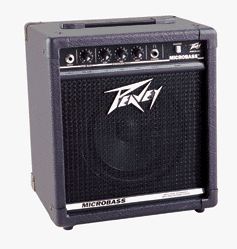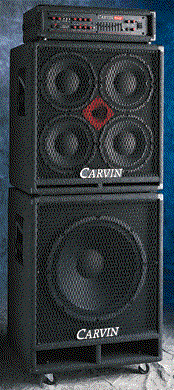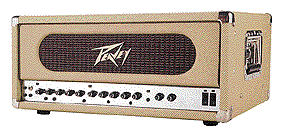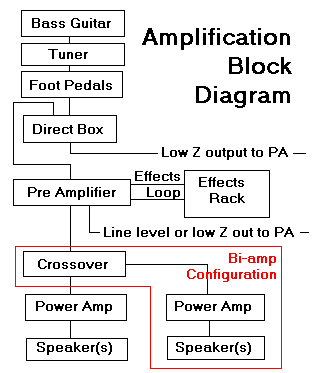The Amplifier
Picking Your Amplifier and Speakers

Picking your amplifier is going to depend on; where are you are going to be playing most often, how loud does it need to be, what kind of sound you want, how big or small does it need to be, and not least of which, what is your budget?
If you are playing in mostly garages, small rehearsal rooms, and small clubs, you don't need much more than about 100 Watts to 200 Watts of output power. If you only need a practice amp to play in your bedroom with a small stereo or jam box, you can use an amp anywhere from 20 Watts to 50 Watts. If you are playing large clubs or outside, you will need at least 300 Watts or more.
One thing to remember when you are playing outside or in a large club is that your amplification for the most part is for you and the other members of the band on stage and the people right in front of the stage. This is called the "stage mix". The rest of the people are really listening to the P.A. The house speakers or system is what most people will hear. So contrary to what some might think, you can have it really blasting out in the audience and still be able to talk to each other on stage. Be careful not to have the stage volume louder than the P.A. as this will usually mean that the audience mix is not that great. This is because some instruments will sound fine to you on stage, however out in the audience, they can't hear it or will say it is too loud.
NOTE! A public service message here is... PROTECT YOUR EARS! Don't play games with your ears and think you can take it. Once you can't hear any more, YOU CAN'T HEAR! Wear ear plugs or just keep the volume down. After extended periods of playing give your ears a rest. If you hear ringing after you play, you are not protecting your ears. You don't want to have the ringing continue forever and it can. It is called tinnitis.
Amp Types

Bass Amps come in two basic configurations. The stacked amp configuration is one or two speaker cabinets with an amplifier in its own box or rack case. This type of configuration can be tough to handle. Just ask any Ampeg SVT stack owner. You will probably need a pickup or van to carry it around and don't forget the hand truck. Stairs can be a real challenge. The major advantages with a stacked configuration are; you can get much more volume output, separation with multiple speaker cabinets, and upgrade portions rather than the whole thing.
Combo amps are where you have a single unit that contains the amplifier and the speakers. Usually these types of amps are used for low volume and practice situations. They can be small and compact so it's easy to setup and transport around.
Tube Amps
Traditionally tube amplifiers will give you a distorted to warm fat sound. They usually have much more punch than the other types of amplifiers. Tube amplifiers are also more expensive to maintain and can be somewhat problematic. Tubes are getting hard to find these days. Especially USA made tubes. The Ampeg SVT is an example of a powerhouse tube amplifier. Older Fender amps like the Bassman are tube amps.
Solid State Amps
Solid state, meaning all transistors and no tubes, amplifiers will give you top end and more of an artificial sounding bottom end. The solid state also gives you a very clean sound. These amplifiers are generally more reliable and are less expensive getting them back out of the repair shop. Solid state amps include Peavy and Galleon Kruger.
Hybrid Amps
The typical hybrid amplifiers will have a tube pre-amp and a solid state power amplifier. This gives you the warm sound of the tube amplifiers and the clean crispiness of the solid state amplifiers. The hybrids can provide more versatility than the other types of amplifiers. A good example of the hybrid amps are the SWR bass amps.
Power Output

The power output of an amplifier is measured in watts. For tube amps, watts are measured in x number of watts RMS and solidstate and most hybrids are measured in peak-to-peak (pp. or ptp) measurements.
A 50 watt RMS amplifier will problably be as loud as a 100 watt pp. amplifier. Typical practice amps will be 10 to 40 watts both peak-to-peak and RMS. Amps of 50 to 200 watts are good for garages and small clubs. Unless you are playing outdoors or can get away with playing really loud, you don't need the 300, 400, and higher wattage amplifiers.
Controls
Most bass amplifiers are setup with a pre-amp section and a main section. Usually all you get with the pre-amp is a gain setting and an effects loop. This is then sent to the main power amp where the tone and equalization is produced.
Input
Most modern bass amps have a way to handle passive versus active basses. Some will be marked Active and Passive while others will have a something like a -10db cut. Utilize the cut switch for active basses. In reality, you can plug an active bass into a passive input or not hit the cut switch. What they are trying to do is make sure you don't peak out the pre amp. When the preamp peaks out that means the signal gets to its maximum voltage and can't go any higher so it flattens out thus cutting off the wave. This cuttoff usually presents itself as distortion. This may be what you are going for. For the most part, the only thing you have to worry about is blowing speakers. A good cabinet with plenty of headroom should be fine.
Tone Controls
Most bass amps have at least a bass and treble tone control. Some have a midrange (mid) tone control and others have multi-band equalizers. There is no propper setting and how you set the tone controls are going to depend on the room you are in, the number of people in the room, the types of speakers you are using, the bass you are using, and the sound of the rest of the band. Far too much to get into here. However, from a basic standpoint, when you are trying to get a sound, start by setting everthing to neutral. Then figure out what you are missing and rather than just boosting what you need more of, cut everything else. So if you need more highs, cut the bass before you boost the highs.
Compression
Compression is where the single is evened out so that the really loud isn't as loud and the really soft is not so soft. It kind of evens things out. This is especially important for slapping. Not all basses have compression circuitry but most of the top end contemporary amps do. Find the point where it doesn't cut too much but cuts enough to keep the peaks minimized.
Master Volume
This is the last knob before your sound is sent to the speakers. In most cases you will never have your knob at 10 and if you find you have to to keep up with the rest of the band then you need a bigger amp and or more speakers.
Effects
Just about any effect that works for guitar can work for the bass. Even a tremolo bar. Some effects work better than others. Effects fall into a few categories; delay, tone and pitch. Delay types of effects are called chorus, echo, or delay. It just depends on the delay time.
Chorus
A chorus is a very short delay. A good effect for the fretless bass is chorus. It adds to its depth. The chorus makes the sound fatter by making it sound like there is more than one person playing. It sounds like two people playing the same part. A chorus device will usually have two main settings; depth and rate. The depth refers to how much effect you want to apply to the original signal. Rate determines how much vibrato there is in the effect. You typically want to match the rate of the chorus to the tempo of the song. If you are off, it can make you sound out of tune.
Delay
The delay can be from half of a second to many seconds. This is very useful when playing a lick that you want to overlap on itself. It can be long enough to where you play a sort of call and answer with the delay. Although this effect is used mainly by lead guitarists, there is no reason it can't be used effectively with the bass.
Echo and Reverb
The echo or reverb sounds like a large cement room.
The devices that effect tone are Flangers, Wah-Wah pedals and octave or harmony. Flangers have a sound that goes higher and lower between the bass and treble tones in a rhythmic pattern that sounds like it is going back and forth.
Wah-wah pedals are for the most part like having a pedal you can move back and forth to turn your treble or bass tone knobs. This effect is typically used for guitar.
Octave and harmony effects play accompaniment with you only an octave lower, two octaves lower, higher some other interval like a 3rd or 5th. The more common ones are the octave boxes. They are useful when playing up on the neck and having the effect generate the octave or two below what you are playing. It really gives the bass a fat sound. Be careful not to hit more than one note. Most will have trouble differentiating between the two note and cut back and forth for an undesired effect.
Battery power effects can be a pain. They run out fast. You can drain a foot pedal effect in a couple hours of being turned on. Not only that, batteries in circuit between the bass and the amp can add noise. Rack mount effects generally have the most control and are much quieter. The worst is trying to deal with a noisy effect when you are trying to record.
A compressor is a device that tries to equalize the loudness of the notes you play. You set a threshold that tells the compressor when it should take effect and it then tries to flatten out the volume. This effect is very useful for doing any kind of slap playing.
Hooking It All Up
 The signal path will start with the bass of course and optionally can connect to an electronic tuner. It is important to connect an in line tuner directly to the bass to give it the truest signal. Effects can cause problems for a tuner. Then connect to your foot pedals or stomp boxes.
The signal path will start with the bass of course and optionally can connect to an electronic tuner. It is important to connect an in line tuner directly to the bass to give it the truest signal. Effects can cause problems for a tuner. Then connect to your foot pedals or stomp boxes.
From here you can connect to a direct box. The direct box is usually used in recording and even more often when playing live and sending to the PA system. What it does is splice into the signal from the base going to the amp and sends a low Z output to the PA or recorder. The low Z output is a much cleaner way to send a signal a longer distance, from the stage to the mixing booth in the back of the room for instance, with minimal signal loss and noise.
Next you connect to the pre-amplifier (pre-amp). The pre-amp and the power amp are usually built into the same unit, however you can get them separately. If you are running a bi-amp configuration, you will need to have a separate pre-amp and power amp. A bi amp configuration is used when you want to amplify a certain range of frequencies through one speaker cabinet and different set of frequencies though another type cabinet. Usually this means sending only the highs to a horn or small, 8" or 10" diameter speakers. Then the mid and low range frequencies are sent to larger speakers typically 12" to 18" in diameter..
The pre-amp is usually where an effects loop will be. Older amplifiers don't typically have effects loops. The effects loop is simply an effects loop out connection and a effects loop in connection. The effects loop is a way to connect a stack of effects each one feeding into the next in a daisy chain fashion and then back to the pre-amp. Effects loops are cleaner than your foot pedals. You will notice hum and buzz being generated by the foot pedals much more so than on typical rack effects.
The pre-amp may have a line out. The line out will come in two types of connectors; 1/4" jack and low-Z XLR connectors. This type of output is used to send a signal to the PA, mixing board, recorder, boom box, etc.
If you are using a bi-amp or tri-amp configuration, you connect the pre-amp to the crossover. The crossover separates the signal into separate frequency ranges. Each separate frequency range is then sent to individual power amplifiers and speakers.
In a normal configuration, the pre-amp connects to the power amp and then to the speaker(s).
Care & Maintenance
Even if you aren't an electronics wiz who can repair your own equipment, there are some things you can do to maximize the life of your electronics. Power is one of the most important things regarding your equipment. Carrying a circuit tester to make sure that the circuit you plug into is good can help save you from blowing an amp. Here are some things you can do to maximize the life of your equipment.
- Move the knobs periodoically. By moving each one of the knobs on your amp you help to prevent dust buildup, which is what causes the scratching noice you hear when you turn a knob.
- Let your tube amp cool down before you move it. Your tubes will last longer.
- Always use a surge suppressor.
- Use a can of compressed air to blow out any dust that may build up, especially if there is a fan.
